by Mary Hrovat
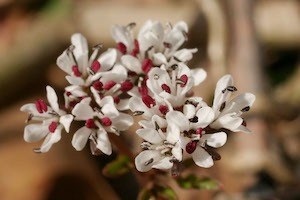 The spring ephemeral wildflowers of the Midwest are generally not large or showy. In a relatively short time during one of the less promising parts of the year, these perennial plants must put out leaves and flowers and reproduce, all before disappearing until the next spring. Still, they light up the woods for me every year despite their relatively modest circumstances.
The spring ephemeral wildflowers of the Midwest are generally not large or showy. In a relatively short time during one of the less promising parts of the year, these perennial plants must put out leaves and flowers and reproduce, all before disappearing until the next spring. Still, they light up the woods for me every year despite their relatively modest circumstances.
One of the earliest spring ephemerals, harbinger of spring, may be the most inconspicuous. The plant is usually no more than a few inches tall when it blooms, and if you don’t keep an eye out for it, you could walk right by and not know it’s there. Unless you kneel down and look closely, the leaves are little more than a small green patch dotted by tiny white flowers. Closer inspection reveals that the flowers have five white petals and deep red anthers, which darken with time and give the flowers a charming salt-and-pepper look. Harbinger of spring can appear as early as February, when the weather has been cold for months and the trees are bare. It’s a minute but electrifying herald of warmer and greener days to come.
Spring beauty and bloodroot also appear very early. Spring beauty has long narrow leaves and small starry white flowers striped with pink veins; it’s one of my favorites because of its lovely colors. Bloodroot (Sanguinaria canadensis) gets its name from its reddish rootstock, which produces a sap that has been used as a dye. The flowers are pure white with bright yellow centers. Before each one emerges, it’s surrounded by the plant’s single multi-lobed leaf; the leaf then unfolds, setting the flower free. Like those of some other spring ephemerals, the flowers of bloodroot open in the daytime and close at night. Late in the day, as they’re closing, the flowers look like little white bubbles at the end of thin stalks. When the plant is finished blooming, the leaf grows larger; the seed pod sits at its center.
I watch the spring ephemerals come and go in a small wooded area on a nearby college campus. As I write, there’s still some harbinger of spring in bloom, but not as much as there was a few weeks ago. Bloodroot is finished blooming, but the distinctively shaped leaves and the seed pods of the plants are visible. Spring beauty has been in bloom for a couple of weeks.
###
During the first week in April, toothwort was by far the most obvious blooming plant in the woods. The toothworts are members of the genus Cardamine; the species I see every year is called cutleaf toothwort (Cardamine concatenata). My mnemonic for toothwort, when I was first learning about the spring ephemerals, was that the leaves of this species are dentate (toothed). However, the toothworts as a group are named for the fact that the rootstock is tooth-shaped. The four-petaled flowers appear in clusters ranging in color from white to a subtle pink.
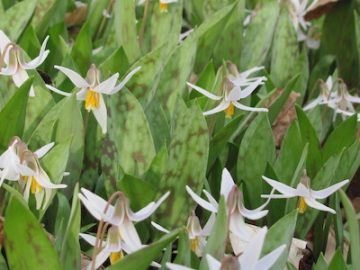 When I walked through the woods on April 7 of this year, the trout lilies were in bud and just starting to open. The next day, it looked like they had all burst into flower. The blade-like leaves of this plant are easily recognized because of their brown mottling, which is similar to the markings on the brook trout. There are two types of trout lily in the urban woods I visit. Most of them are Erythronium albidum, which has white flowers, but some are Erythronium americanum, which has yellow flowers. I was confused by these two trout lilies when I was first learning about the spring ephemerals, because they’re also called dog-tooth violets, although they’re not violets. “Dog-tooth” is also a reference to the appearance of the root.
When I walked through the woods on April 7 of this year, the trout lilies were in bud and just starting to open. The next day, it looked like they had all burst into flower. The blade-like leaves of this plant are easily recognized because of their brown mottling, which is similar to the markings on the brook trout. There are two types of trout lily in the urban woods I visit. Most of them are Erythronium albidum, which has white flowers, but some are Erythronium americanum, which has yellow flowers. I was confused by these two trout lilies when I was first learning about the spring ephemerals, because they’re also called dog-tooth violets, although they’re not violets. “Dog-tooth” is also a reference to the appearance of the root.
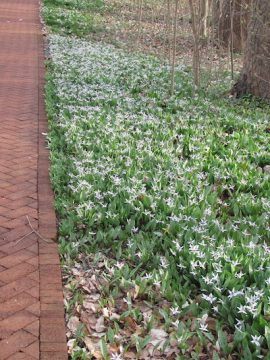 Like all of the spring ephemerals, the trout lily is low-growing and not particularly noticeable unless you’re looking for it—until it starts to bloom. The individual flowers are beautiful from up close, hanging from curved stems and nodding gently when there’s a breeze. The plants tend to grow in large colonies, and they can be dazzling when hundreds of flowers appear overnight in great drifts of white among last year’s dead leaves.
Like all of the spring ephemerals, the trout lily is low-growing and not particularly noticeable unless you’re looking for it—until it starts to bloom. The individual flowers are beautiful from up close, hanging from curved stems and nodding gently when there’s a breeze. The plants tend to grow in large colonies, and they can be dazzling when hundreds of flowers appear overnight in great drifts of white among last year’s dead leaves.
I’ve spotted a few other spring ephemerals in this urban woods—Dutchman’s breeches, for example, a plant with feathery leaves and flowers that grow along more or less vertical stalks and look like wee pairs of upside-down puffy white pants. (This plant is in the genus Dicentra; the pink and white bleeding heart that is often grown in gardens is also in this genus.) There are a few trilliums scattered here and there; it’s easy to recognize them by their group of three leaves. As I write this, they are in bud, but their burgundy-colored flowers have yet to unfurl. This year I discovered a small patch of what I’m pretty sure is false rue anemone. In wilder areas outside of town, you can find other spring ephemerals, such as Virginia bluebells, which can cover the ground in a beautiful pale blue, and bright yellow celandine poppies. The great thing about the little woodland I visit is that it’s close enough that I can walk through it as often as I like.
###
The spring ephemerals show up so early in the season because they’re taking advantage of the sunlight reaching the forest floor before leaves appear on the trees. To accommodate their short season of activity during often cold and unpredictable weather, these plants generally need deep, rich soils. Many of them have symbiotic relationships with fungi that help the plants take up nutrients and water, which is harder in cooler weather.
Pollinators are fewer, and many of the spring ephemerals rely on native bees (rather than the non-native western honey bee) and flies. Spring beauty and the trout lily each have a specialized pollinator: Andrena erigeniae (the spring beauty andrena) and Andrena erythronii (the trout lily bee, a name that delights me). Like the flowers they visit, these bees spend only a short time above-ground; they then retire to underground nests for the rest of the year.
By the time summer starts, most of the spring ephemerals are just a memory until the next year. The above-ground phase of their life cycle ends as the air warms and the trees of the forest leaf out and shade the ground. When the leaves of the ephemerals die back, nutrients are drawn from them into the root tissue and stored there. In the autumn, as the trees prepare for winter’s sleep, the underground phase of life begins for the spring ephemerals. During autumn and winter, under the fallen leaves and the snow, the plants use some of the stored nutrients to develop buds and put out roots. When spring approaches, more nutrients are used to feed the growth of leaves and stems, as the plants launch into another brief season of growth and reproduction.
###
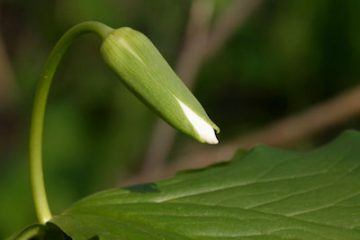 The word ephemeral comes from the Ancient Greek word for day. In English, ephemeral was originally used to describe an illness, or a lifespan, that lasted for a day. Mayflies, some of which don’t live long enough in their adult form to need working mouths, belong to an order of insects called Ephemeroptera. The mayfly is emblematic of the brevity of life.
The word ephemeral comes from the Ancient Greek word for day. In English, ephemeral was originally used to describe an illness, or a lifespan, that lasted for a day. Mayflies, some of which don’t live long enough in their adult form to need working mouths, belong to an order of insects called Ephemeroptera. The mayfly is emblematic of the brevity of life.
Ephemeral was first used to mean transitory in the 17th century. Spring ephemeral wildflowers don’t necessarily bloom for just a day, but still, they’re not around for long, and the opportunity to see them must be seized before it vanishes. They disappear so completely after they’re done blooming, when so many other flowering plants stay green and visible for months, that they can certainly evoke the bittersweet sense of fleeting time.
In Ancient Greek, ephemeros means daily or for the day, and the English word ephemeris carries this meaning of something associated with a particular day. Ephemerides are used in astronomy and celestial navigation; they list the positions of celestial objects for each day (along with various other attributes, such as rising and setting times, brightness, and/or distance), the phase of the moon, and any interesting celestial events such as a conjunction of two planets or an eclipse.
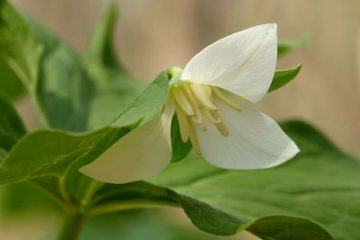 Ephemeris reflects not a sense of brevity but rather the particularity of each day, with its configuration of planets and asteroids, moon and sun. The spring ephemerals can also be looked at in this light. Each day in the woods is a little different from the day before, as each plant moves through its season of leaf and bloom. It’s worth going out often to see the leaves and buds and flowers of this day. This one and only day.
Ephemeris reflects not a sense of brevity but rather the particularity of each day, with its configuration of planets and asteroids, moon and sun. The spring ephemerals can also be looked at in this light. Each day in the woods is a little different from the day before, as each plant moves through its season of leaf and bloom. It’s worth going out often to see the leaves and buds and flowers of this day. This one and only day.
###
The title of this essay comes from Charles Algernon Swinburne. Some of the photos (harbinger of spring, top; drooping trillium bud and bloom, bottom) are the work of Cecelia Alexander. The others are mine.
You can see more of my writing at maryhrovat.com.
